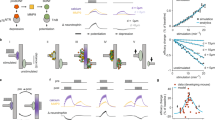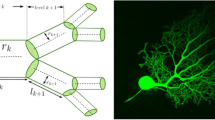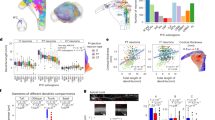Abstract
The total length of cortical axons could be reduced if the parent axons maintained straight trajectories and simply connected to dendritic shafts via spine-like terminaux boutons and to dendritic spines via bead-like en passant boutons. Cortical axons from cat area 17 were reconstructed from serial electron micrographs and their bouton morphology was correlated with their synaptic targets. En passant or terminaux boutons did not differ in the proportion of synapses they formed with dendritic spines and shafts, and thus, the two morphological variants of synaptic bouton do not contribute directly to optimizing axon length.
This is a preview of subscription content, access via your institution
Access options
Subscribe to this journal
Receive 12 print issues and online access
$209.00 per year
only $17.42 per issue
Buy this article
- Purchase on Springer Link
- Instant access to full article PDF
Prices may be subject to local taxes which are calculated during checkout

Similar content being viewed by others
References
Braitenberg, V. & Schüz, A. Anatomy of the Cortex (Springer, Berlin, 1991).
Peters, A. & Kaiserman-Abramof, I. R. Am. J. Anat. 127, 321–356 (1970).
Swindale, N. V. Trends Neurosci. 4, 240–241 (1981).
Gray, E. G. Trends Neurosci. 5, 5–6 (1982).
Fischer, M., Kaech, S., Knutti, D. & Matus, A. Neuron 20, 847–854 (1998).
Engert, F. & Bonhoeffer, T. Nature 399, 66–70 (1999).
Maletic-Savatic, M., Malinow, R. & Svoboda, K. Science 283, 1923–1927 (1999).
Toni, N., Buchs, P.-A., Nikonenko, I., Bron, C. R. & Muller, D. Nature 402, 421–425 (1999).
McGuire, B. A., Hornung, J.-P., Gilbert, C. D. & Wiesel, T. N. J. Neurosci. 4, 3021–3033 (1984).
Martin, K. A. C. & Whitteridge, D. J. Physiol. (Lond.) 353, 463–504 (1984).
Muller, W. & Connor, J. A. Nature 354, 73–76 (1991).
Guthrie, P. B., Segal, M. & Kater, S. B. Nature 354, 76–80 (1991).
Majewska, A., Tashiro, A. & Yuste, R. J. Neurosci. 20, 8262–8268 (2000).
Tarczy-Hornoch, K., Martin, K. A. C. & Stratford, K. J. Cereb. Cortex 9, 833–843 (1999).
Acknowledgements
We thank T. Binzegger for help with calculations and reconstructions. Additional support from EU (QULG3-1999-01064) and HFSP (RG0123/2000-B) grants to K.A.C.M.
Author information
Authors and Affiliations
Corresponding authors
Supplementary information
Supplementary Figure 1
Three-dimensional reconstruction from serial ultrathin sections of a labeled spiny stellate axon showing boutons and their targets in layer 2/3 of area 17 in cat visual cortex. (a) The radially aligned axon (blue) provides six bouton terminaux and two bouton en passant. The boutons terminaux and a single bouton en passant form a cluster and are centrally located. The second bouton terminaux is located at the uppermost end of the reconstruction. Three of the boutons formed synapses with dendritic shafts (light red) of which two formed numerous other asymmetric synapses (yellow) with unidentified boutons. The remaining boutons terminaux and bouton en passant formed synapses with spines (light brown/orange). (b) Detail of the central portion of the reconstruction seen in (a). The slender necks of the boutons terminaux are more clearly visible at this magnification. Color code as in (a). Scale bar, 2 μm. (PDF 634 kb)
Supplementary Figure 2
Reconstructions of labeled boutons in layer 2/3 from spiny stellate and pyramidal neurons in cat visual cortex. (a) A bouton terminaux (transparent blue) from a layer 3 pyramidal neuron forms a synapse with a spine (brown) that can be traced back to the parent dendrite (gray). Adjacent to the contacted spine is a second spine (brown) forming a complex asymmetric synapse with puncta adherens (all shown in yellow). (b) A small bouton terminaux (blue) from a layer 3 pyramidal neuron forms a synapse (yellow) with a dendritic shaft (transparent gray). The parent axon is in contact with the dendrite (lower right) and passes orthogonal to it but projects a short (~0.5 μm) bouton terminaux to form a synapse. (c) Two closely spaced (~2 μm) bouton en passant (transparent blue) from a spiny stellate neuron form synapses (yellow) with spines (transparent brown). Both boutons appear as swellings on the axon however the synapse of the lower bouton is formed on the surface that is projected away from the path of the axon. The synapse on the uppermost bouton is formed on the surface that is closest to the path of the axon and the swelling, which contains the synaptic vesicles and mitochondria, projects away from the synapse. (d) A bouton terminaux (blue) from a spiny stellate neuron forms a perforated synapse (yellow) with a spine (transparent brown). The spine lies on the path of, and is in contact with, the axon. But the synapse is formed by the bouton passing around a myelinated axon (transparent purple) and coming back to meet the path of the axon. The bouton lies adjacent both to the axon and the spine. Axes, 0.5 μm. (PDF 1527 kb)
Rights and permissions
About this article
Cite this article
Anderson, J., Martin, K. Does bouton morphology optimize axon length?. Nat Neurosci 4, 1166–1167 (2001). https://doi.org/10.1038/nn772
Received:
Accepted:
Published:
Issue Date:
DOI: https://doi.org/10.1038/nn772
This article is cited by
-
Translaminar circuits formed by the pyramidal cells in the superficial layers of cat visual cortex
Brain Structure and Function (2017)
-
Three-dimensional reconstruction of synapses and dendritic spines in the rat and ground squirrel hippocampus: New structural-functional paradigms for synaptic function
Neuroscience and Behavioral Physiology (2005)
-
Genesis of dendritic spines: insights from ultrastructural and imaging studies
Nature Reviews Neuroscience (2004)
-
Reach out and touch
Nature Reviews Neuroscience (2002)



